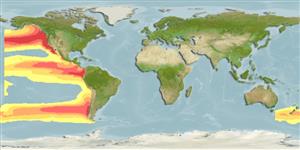>
Lampriformes (Velifers, tube-eyes and ribbonfishes) >
Trachipteridae (Ribbonfishes)
Etymology: Trachipterus: Greek, trachys, -eia, -ys = rough + Greek, pteron = wing, fin (Ref. 45335); altivelis: From the Latin 'altus' meaning high and 'velum' meaning sail - referring to the high doral fin (Ref. 6885).
More on author: Kner.
Environment: milieu / climate zone / depth range / distribution range
Ecologia
marinhas; oceanódromo (Ref. 51243); intervalo de profundidade 0 - 900 m (Ref. 36610). Subtropical; 60°N -
Eastern Pacific: Alaska to Chile.
Tamanho / Peso / Idade
Maturity: Lm ? range ? - ? cm
Max length : 183 cm TL macho/indeterminado; (Ref. 2850)
Descrição suscinta
Morfologia | Morfometria
Espinhos dorsais (total): 0; Raios dorsais (total): 165-184; Espinhos anais 0; Raios anais : 0; Vértebras: 90 - 94. First 5 rays of dorsal fin greatly elongated in young becoming reduced with age, otherwise rather higher in center, extending almost to caudal and ends abruptly (Ref. 6885); caudal fin highly asymmetric, dorsal lobe becomes well developed in juveniles with 7-8 rays directed upward at an angle of 45° to body axis, and eventually with growth is much reduced; ventral lobe elongate in young specimens becoming reduced to 5-6 spines directed backward from the caudal base in older individuals; anal fin absent; pectorals small, rounded; pelvic fins elongate in young and juveniles, reduced to base in larger individuals (Ref. 6885). Juveniles iridescent silvery with a series of about 4 dark blotches spaced above lateral line canal; upright and pelvic fins carmine red; larger individuals rather very silvery and greener with light spots, around scales; posterior end of dorsal fin darker (Ref. 6885).
Oceanic (Ref. 2850). Also found near shore, but large adults sometimes feed on the bottom (Ref. 2850). Small individuals feed on copepods, annelid worms, and fish larvae; larger individuals feed on copepods, euphausiids, small pelagic fishes, young rockfishes, squid, and Octopoda (Ref. 6885). Oviparous, with planktonic eggs and larvae (Ref. 36610).
Ciclo de vida ou comportamento de acasalamento
Maturidade | Reprodução | Desova | Ovos | Fecundidade | Larvas
Eschmeyer, W.N., E.S. Herald and H. Hammann, 1983. A field guide to Pacific coast fishes of North America. Boston (MA, USA): Houghton Mifflin Company. xii+336 p. (Ref. 2850)
Status na Lista Vermelha da UICN (Ref. 130435)
Ameaça para os humanos
Harmless
Uso pelos humanos
Mais informação
Idade/TamanhoCrescimentoPeso-comprimentoComprimento-comprimentoFrequências de comprimentoMorfometriaMorfologiaLarvasDinâmica larvalRecrutamentoAbundânciaBRUVS
ReferênciasAquaculturaPerfil para aquaculturaEstirpesGenéticaElectrophoresesHereditariedadeDoençasProcessamentoNutrientsConversão de massa
Ferramentas
Relatórios especiais
Baixar XML
Fontes da internet
Estimates based on models
Preferred temperature (Ref.
123201): 5.9 - 10.4, mean 7.7 °C (based on 77 cells).
Índice de diversidade filogenética (Ref.
82804): PD
50 = 0.5166 [Uniqueness, from 0.5 = low to 2.0 = high].
Bayesian length-weight: a=0.00102 (0.00046 - 0.00225), b=3.06 (2.88 - 3.24), in cm total length, based on all LWR estimates for this body shape (Ref.
93245).
Nível Trófico (Ref.
69278): 3.9 ±0.48 se; based on food items.
Resiliência (Ref.
120179): Baixo, tempo mínimo de duplicação da população 4,5 - 14 anos (Assuming tmax>10).
Fishing Vulnerability (Ref.
59153): Very high vulnerability (90 of 100).
